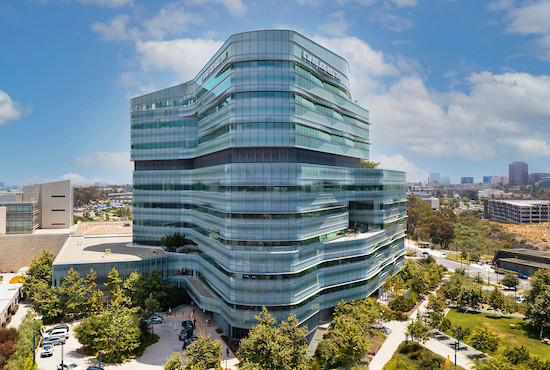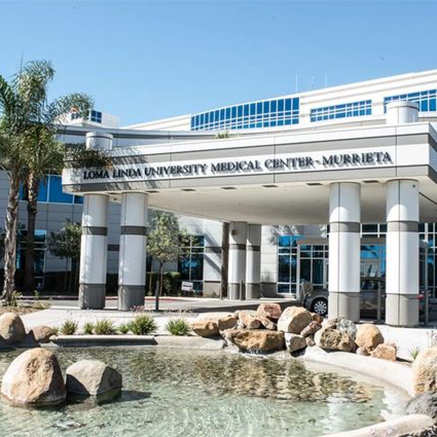Locations
Rotations
Equal periods of time are spent at the UC San Diego Medical Center and the La Jolla VA Medical Center, which are located across the street from each other. There is a two-month congenital cardiac surgery rotation which takes place at Rady Children’s Hospital. For interested residents, there is an opportunity to rotate at a community-based practice, Loma Linda University Medical Center – Murrieta (which is staffed by UC San Diego CT surgeons).
Locations
 UC San Diego Health – La Jolla
UC San Diego Health – La Jolla
UC San Diego Health in La Jolla is the flagship institution of the UC San Diego healthcare system. The hospital is located in La Jolla, in the northern part of the city of San Diego. The hospital has a total of 419 beds. Of these, 54 beds are exclusively dedicated to the Sulpizio Cardiovascular Center, an integrated institute for medical and surgical treatment of all aspects of cardiovascular disease. This center includes two dedicated intensive care units for cardiology and cardiac surgery patients. The hospital complex also houses the Moores Cancer Center, a National Cancer Institute-designated Comprehensive Cancer Center.
The hospital offers the complete range of cardiothoracic surgical services. Highlights include heart and lung transplantation, robotic general thoracic and cardiac surgery, and the world’s premier pulmonary thromboendarterectomy (PTE) service. There is also a busy extracorporeal membrane oxygenation (ECMO) service and robust endovascular programs including transthoracic aortic valve replacement (TAVR), transcatheter, mitral interventions, and thoracic endovascular aortic repair (TEVAR).
Given the unique and highly specialized care offered at UCSD, there is a truly global catchment area, particularly for PTE and transplant services. Service to the local and regional communities nonetheless remains a priority, and “bread-and-butter" care is delivered to residents of southern California, as well as recent immigrants to the area.
There is a highly collaborative relationship between critical care, surgical, and medical services, which is readily apparent in the mechanical circulatory support services offered and the complex cases, such as open and endovascular aortic procedures. On the general thoracic surgery side, there is a busy interventional pulmonology service, with an option for trainees to hone their schools with that group. Furthermore, there is tremendous support of advanced practice providers (APP) in order to maximize the amount of educationally relevant activity for trainees.
UCSD has a long history of excellent graduate medical education and has ample resident resources. For cardiothoracic trainees, this includes a 24/7 dedicated call room with shower, generous meal allowances for the numerous eateries, and a trainee-only work room which features fitness equipment (treadmills and weights). UCSD also has an active labor union (The Committee of Interns and Residents) which advocates on behalf of all trainees, regardless of their membership in the union, and has been successful in gaining multiple pay raises, in addition to other resident benefits.
 Jennifer Moreno Department of Veterans Affairs Medical Center
Jennifer Moreno Department of Veterans Affairs Medical Center
The San Diego VA Medical Center is in La Jolla, a half-mile away from UCSD Health La Jolla. The hospital has 296 beds and a full complement of medical and surgical services. The VA is a busy site for medical students and trainees of all specialties from UCSD, as well as other institutions, such as Naval Medical Center San Diego (commonly known as “Balboa Hospital”).
There is a dedicated cardiac operating room as well as a DaVinci Xi robotic surgical system. The operating rooms are currently undergoing modernization, which is scheduled to be completed soon. These upgrades include a hybrid operating room, with plans to start a TAVR program upon completion of construction. Cardiac surgical cases place a large emphasis on myocardial revascularization and valvular disease. The general thoracic volumes is primarily related to treatment of neoplasm, with an emphasis placed on robotic cases. A robust multi-disciplinary team reviews all cases prior to surgery and after surgical pathology results have returned.
The catchment area for the hospital includes significant portions of the West Coast and Southwest United States, with veterans coming from out of state.
The strengths of this site are a strong emphasis on all aspects of patient care, with special attention paid to patient selection in clinic, post-operative care in the intensive care unit, and outpatient follow-up. The general surgery residents who also rotate on the cardiothoracic surgery service allow for a more traditional team structure. This provides opportunities for junior residents to learn how to function within a patient care team and for senior residents and fellows to run a service and manage the various responsibilities of a service chief.
 Rady Children's Hospital
Rady Children's Hospital
Rady Children’s Hospital is San Diego’s only hospital which is dedicated exclusively to the care of pediatric patients. The hospital is located approximately ten miles from UCSD Health in La Jolla. The hospital contains 511 beds and is the region’s only pediatric trauma hospital (Level I). Furthermore, the hospital has the region’s only Level IV neonatal intensive care unit (NICU), which is 60 beds. There is also a separate, dedicated cardiac intensive care unit. Approximately 400 cardiac surgical cases are performed annually. The heart failure program at Rady includes temporary and durable mechanical circulatory support, including ECMO, as well as a busy heart transplant component. The catchment area for Rady Children’s Hospital includes Southern California, Arizona, and the Pacific Islands.
There is a large graduate medical education presence at Rady Children’s hospital, providing strong social and academic support. Each year, over 500 residents and more than 150 fellows participate in patient care at Rady. However, for cardiothoracic surgical residents and trainees, there are no competing learners. Trainees at Rady participate in all aspects of multidisciplinary care of patients with complex congenital heart disease, including ICU rounds and clinic. The weekly congenital heart disease conference is highly attended and educational, providing insights to all aspects of patient care.
 Loma Linda University Medical Center – Murrieta
Loma Linda University Medical Center – Murrieta
Loma Linda University Medical Center (LLUMC) in Murrieta is the newest addition to the UCSD Health educational portfolio. The hospital, opened in 2011 and featuring 106 beds, is located in Murrieta, CA, 62 miles northeast of San Diego. Trainees will work with two cardiothoracic surgeons who are both UCSD faculty, one of whom also works at UCSD Health in La Jolla.
LLUMC offers trainees the opportunity to experience community-based CT surgery practice and teaches invaluable skills in practice management and interactions with referring physicians and services. Trainees can expect to be heavily involved in cases involving coronary artery disease, complex valve pathology, and percutaneous management of aortic valve disease. The surgeons also manage benign and malignant general thoracic conditions.
Formal educational opportunities include tumor board as well as participation in the fellow didactics and morbidity and mortality conference offered by UCSD Health in La Jolla.
The catchment area includes much of the “Inland Empire” region of Southern California. This provides a unique opportunity for trainees, as this area has a relative paucity of cardiothoracic surgeons and provides exposure to a different patient population than might be encountered in San Diego.
As trainees from the main Loma Linda University Hospital also rotate at LLUMC in Murrieta, there is a well-established graduate medical education infrastructure. In addition to a GME office, this also includes call rooms, dedicated resident work areas, and free meals.
